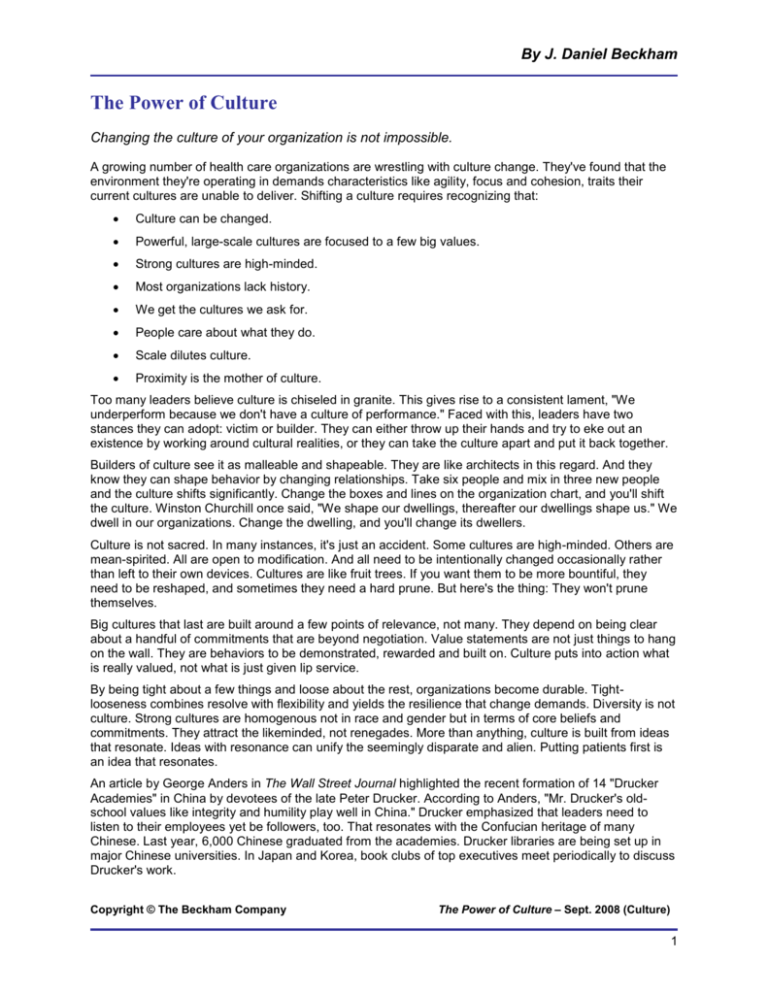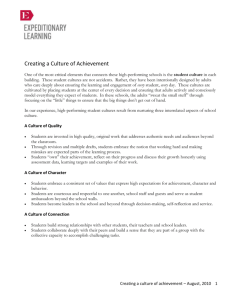The Power of Culture - The Beckham Company
advertisement

By J. Daniel Beckham The Power of Culture Changing the culture of your organization is not impossible. A growing number of health care organizations are wrestling with culture change. They've found that the environment they're operating in demands characteristics like agility, focus and cohesion, traits their current cultures are unable to deliver. Shifting a culture requires recognizing that: Culture can be changed. Powerful, large-scale cultures are focused to a few big values. Strong cultures are high-minded. Most organizations lack history. We get the cultures we ask for. People care about what they do. Scale dilutes culture. Proximity is the mother of culture. Too many leaders believe culture is chiseled in granite. This gives rise to a consistent lament, "We underperform because we don't have a culture of performance." Faced with this, leaders have two stances they can adopt: victim or builder. They can either throw up their hands and try to eke out an existence by working around cultural realities, or they can take the culture apart and put it back together. Builders of culture see it as malleable and shapeable. They are like architects in this regard. And they know they can shape behavior by changing relationships. Take six people and mix in three new people and the culture shifts significantly. Change the boxes and lines on the organization chart, and you'll shift the culture. Winston Churchill once said, "We shape our dwellings, thereafter our dwellings shape us." We dwell in our organizations. Change the dwelling, and you'll change its dwellers. Culture is not sacred. In many instances, it's just an accident. Some cultures are high-minded. Others are mean-spirited. All are open to modification. And all need to be intentionally changed occasionally rather than left to their own devices. Cultures are like fruit trees. If you want them to be more bountiful, they need to be reshaped, and sometimes they need a hard prune. But here's the thing: They won't prune themselves. Big cultures that last are built around a few points of relevance, not many. They depend on being clear about a handful of commitments that are beyond negotiation. Value statements are not just things to hang on the wall. They are behaviors to be demonstrated, rewarded and built on. Culture puts into action what is really valued, not what is just given lip service. By being tight about a few things and loose about the rest, organizations become durable. Tightlooseness combines resolve with flexibility and yields the resilience that change demands. Diversity is not culture. Strong cultures are homogenous not in race and gender but in terms of core beliefs and commitments. They attract the likeminded, not renegades. More than anything, culture is built from ideas that resonate. Ideas with resonance can unify the seemingly disparate and alien. Putting patients first is an idea that resonates. An article by George Anders in The Wall Street Journal highlighted the recent formation of 14 "Drucker Academies" in China by devotees of the late Peter Drucker. According to Anders, "Mr. Drucker's oldschool values like integrity and humility play well in China." Drucker emphasized that leaders need to listen to their employees yet be followers, too. That resonates with the Confucian heritage of many Chinese. Last year, 6,000 Chinese graduated from the academies. Drucker libraries are being set up in major Chinese universities. In Japan and Korea, book clubs of top executives meet periodically to discuss Drucker's work. Copyright © The Beckham Company The Power of Culture – Sept. 2008 (Culture) 1 By J. Daniel Beckham Discovery is a strong force in the culture of Johns Hopkins. It attracts people who care about discovery. Discovery at Hopkins is also entrepreneurial. It requires self-starters who can make a lot out of relatively limited resources because Hopkins has never been as richly endowed as many other academic universities. Cultures attract those whose values are valued. Hopkins got pioneers. Enron got crooks. Abraham Maslow's "hierarchy of needs" remains a powerful depiction of human motivation. It is usually depicted as a pyramid with five levels. Working from the bottom up, the fundamental biological and psychological needs, such as food, water, warmth and sleep, are expressed at the first level. Next, on the second level, are safety needs. Employment goes here, along with basic financial requirements. The next three levels include the needs related to belongingness, esteem and self-actualization (personal growth and fulfillment). Maslow's hierarchy suggests that individuals cannot move fully to a higher level in the pyramid until the preceding one has been sufficiently satisfied. In my experience, strong organizational cultures are built on the three upper levels. They deliver belongingness, esteem and selfactualization. Meeting basic biological, safety and economic needs does not a strong culture make. If leaders seek to cultivate powerful cultures, they should focus on belonging (collegiality), esteem (recognition) and self-actualization (meaning from work). America is an oddly ahistorical place. American business is even more so. Without a sense of history, cultures are unanchored. To resonate with credibility, organizational values require evidence. People need solid examples of values demonstrated. History provides those examples - stories of values lived out. Without history, organizations are like neighborhoods inhabited by transients. They never develop a sense of place and belonging because they are too mutable. Integrity describes a state of cohesion - a state of being undivided over time and space. History provides opportunities to demonstrate integrity because people can see that the values that mattered yesterday matter today and will matter tomorrow. And they can see that what has been valued in one corner of the organization has been valued in the others. Good history is made of stories. Stories can enthrall and unify. Most health care organizations lack a sense of history. It's not an accident that America's most sustainable health care organizations have been those with a deep sense of history like Mayo Clinic, Cleveland Clinic and Johns Hopkins. If an organization thinks that performance is responsive only to economic incentives, then its leaders shouldn't be surprised when loyalty and commitment are reduced to the size of a bonus check. Enron had a culture. It became what its leaders valued. When Steve Jobs returned to Apple, he asked for a culture of innovation and elegant design. Already, physician organizations whose compensation formulas are geared only to production and income have discovered that they get doctors with their hands on the doorknob and eyes on the clock. Hospitals seeking favorable relationships with physicians emphasize economic alignment and are disappointed when physicians opt for the highest bidder. Cultural values must generate value not only for those inside the organization but even more importantly for those it serves outside the organization. That's the ultimate test of values. Do values create value internally and externally? Culture depends on relevance. Strong cultures are built around things people care strongly about. Orthopedic surgeons care about orthopedic surgery. Nurses care about nursing. Shared experience is the bedrock of relatedness. Doing the same thing generates shared experience. A strong culture among physicians is difficult to achieve across multiple specialties but is intrinsic within a single specialty. Copyright © The Beckham Company The Power of Culture – Sept. 2008 (Culture) 2 By J. Daniel Beckham Make organizations do things they haven't done before and you'll change the culture. We are made by our experiences. And experience is made by action. The nursing culture exists because nurses do nursing. The surgery culture exists because surgeons do surgery. The great architect Louis Sullivan said: "It is the pervading law of all things organic, and inorganic, of all things physical and metaphysical, of all things human and all things super-human, of all true manifestations of the head, of the heart, of the soul, that the life is recognizable in its expression, that Form ever follows function. This is the law." And that's why culture doesn't eat strategy for breakfast. Strategy is defining what's most important to do and doing it. Doing is destiny. It is harder to build and sustain a valuable culture in large organizations. The distance between people diminishes relationships and relevance. This happens from top to bottom. And corner to corner. Durable cultures are composed of subcultures that hold tightly to a few important common values but are unique and unified within themselves. The crucible of battle has consistently demonstrated the power of small within bigness. Soldiers say over and over again that when the bullets fly, they fight most tenaciously not for a nation or a cause but for each other. It's called unit cohesion. A unit consists of a dozen or so individuals. Physicians often suggest that the most workable number of physicians in a group is not 100 but 9 to 12. As the science writer Kevin Kelly is fond of suggesting, you build big things that work out of many small things that work. Take three people and put them together long enough and you get a culture whether you want one or not. By definition, culture describes a state of human relatedness. Cultures are strongest when people see each other and work together. It's tough to foster a culture at a distance. Culture depends on example and the repetition of common behavior. Such behavior must be seen and experienced, not just described. It's often been said that you know someone's heart not by what they say but by what they do. Proximity lets the heart prove its intentions. Culture change is all about people. That's obvious enough. Engineering culture change is all about intentionally shifting ideas and relationships. That requires articulating ideas that matter, redrawing connections and recognizing the organization's most valuable work. In other words, like all management challenges, culture change is all about building value through leadership. Originally published in Hospitals & Health Networks Online Copyright © The Beckham Company The Power of Culture – Sept. 2008 (Culture) 3








